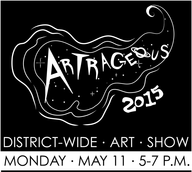Covert, an actor and stagehand with experience in everything from musical comedy to Shakespearean drama, is well-versed in staging a scene and in all of the behind-the-scenes efforts needed to create a world in the mind of an audience. She pulled together all of that (and her considerable artistic skill) to create a set of conceptual illustrations that brilliantly capture the tone of Gaiman's yarn.
Concept art is used in film making, video games, and stage plays to give the director and production designer a better sense of the characters and settings. Covert's work was created as a set of digital paintings in Adobe Photoshop. She utilized a digitizing tablet and stylus, a sort of "digital pen and paper," to create the works. This is a difficult skill to master because the artist is looking at the screen, while using a stylus to draw on a tablet on the table below it.
"American Gods" is a bestselling work of speculative fiction by one of the genre's top authors. The following excerpt from the Publisher's Weekly review gives some sense of the book:
"Titans clash, but with more fuss than fury in this fantasy demi-epic from the author of Neverwhere. The intriguing premise of Gaiman's tale is that the gods of European yore, who came to North America with their immigrant believers, are squaring off for a rumble with new indigenous deities: 'gods of credit card and freeway, of Internet and telephone, of radio and hospital and television, gods of plastic and of beeper and of neon.'"
"Hadestown" is a concept album in which the ancient myth of Orpheus and Eurydice is retold in a "folk opera" form. Mitchell's album is critically praised and has won several awards. It was recently adapted for the stage.
Upon graduation, Emma is attending Franklin and Marshall College to study the Classics and minor in digital art and theater.


 RSS Feed
RSS Feed
